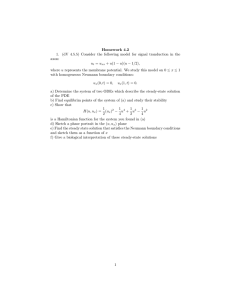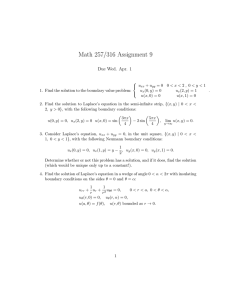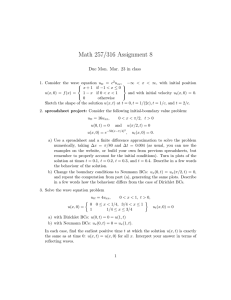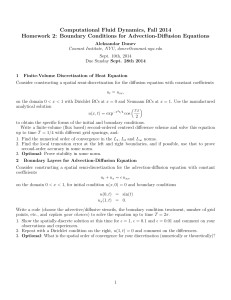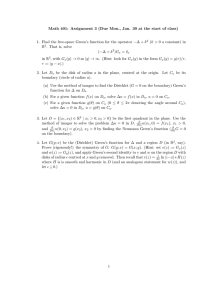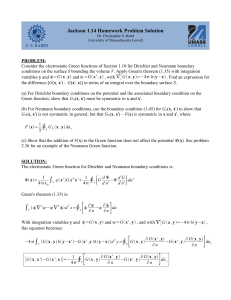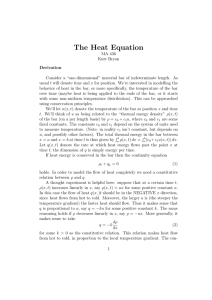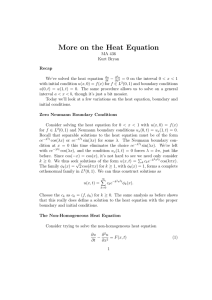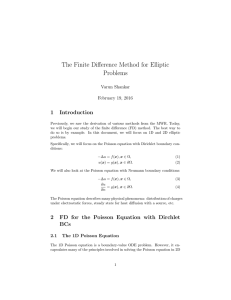Math 401: Assignment 6 (Due Mon., Feb. 27 at the... 1. Consider the heat-equation on the half-line with insulating boundary...
advertisement
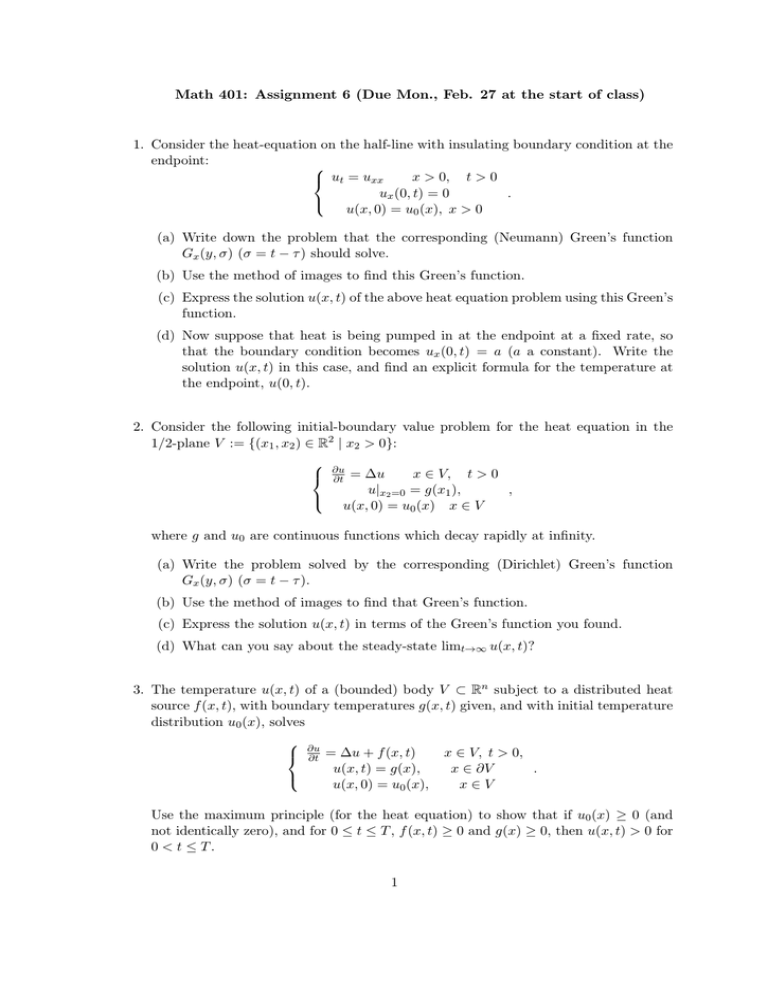
Math 401: Assignment 6 (Due Mon., Feb. 27 at the start of class)
1. Consider the heat-equation on the half-line with insulating boundary condition at the
endpoint:
x > 0, t > 0
ut = uxx
ux (0, t) = 0
.
u(x, 0) = u0 (x), x > 0
(a) Write down the problem that the corresponding (Neumann) Green’s function
Gx (y, σ) (σ = t − τ ) should solve.
(b) Use the method of images to find this Green’s function.
(c) Express the solution u(x, t) of the above heat equation problem using this Green’s
function.
(d) Now suppose that heat is being pumped in at the endpoint at a fixed rate, so
that the boundary condition becomes ux (0, t) = a (a a constant). Write the
solution u(x, t) in this case, and find an explicit formula for the temperature at
the endpoint, u(0, t).
2. Consider the following initial-boundary value problem for the heat equation in the
1/2-plane V := {(x1 , x2 ) ∈ R2 | x2 > 0}:
∂u
∂t
= ∆u
x ∈ V, t > 0
,
u|x2 =0 = g(x1 ),
u(x, 0) = u0 (x) x ∈ V
where g and u0 are continuous functions which decay rapidly at infinity.
(a) Write the problem solved by the corresponding (Dirichlet) Green’s function
Gx (y, σ) (σ = t − τ ).
(b) Use the method of images to find that Green’s function.
(c) Express the solution u(x, t) in terms of the Green’s function you found.
(d) What can you say about the steady-state limt→∞ u(x, t)?
3. The temperature u(x, t) of a (bounded) body V ⊂ Rn subject to a distributed heat
source f (x, t), with boundary temperatures g(x, t) given, and with initial temperature
distribution u0 (x), solves
∂u
∂t
= ∆u + f (x, t)
u(x, t) = g(x),
u(x, 0) = u0 (x),
x ∈ V, t > 0,
.
x ∈ ∂V
x∈V
Use the maximum principle (for the heat equation) to show that if u0 (x) ≥ 0 (and
not identically zero), and for 0 ≤ t ≤ T , f (x, t) ≥ 0 and g(x) ≥ 0, then u(x, t) > 0 for
0 < t ≤ T.
1
4. The temperature u(x, t) of a (bounded) body V ⊂ Rn with insulated boundary, and
with initial temperature distribution u0 (x), solves
∂u
x ∈ V, t > 0,
∂t = ∆u
∂u
.
=
0
x ∈ ∂V
∂n
u(x, 0) = u0 (x)
x∈V
(a) Prove uniqueness for this problem – that is, show that there is at most one
solution u(x, t). (Hint: the maximum principle
R 2 doesn’t help here, because of
d
the Neumann BCs. Instead, compute dt V u (x, t)dx and use the divergence
theorem.)
(b) The steady-states for this problem – i.e. harmonic functions with Neumann BCs
– are just constants. Assuming the solution u(x,
R t) converges to a constant as
d
t → ∞, find that constant. (Hint: consider dt
V u(x, t)dx.)
5. Consider the heat equation in the unit square V = [0, 1] × [0, 1] ⊂ R2 :
∂u
x ∈ V, t > 0,
∂t = ∆u
.
u=0
x ∈ ∂V
u(x, 0) = u0 (x)
x∈V
(a) Find the Green’s function for this problem as an eigenfunction expansion
(b) Write the solution u(x, t) in terms of this Green’s function.
(c) In this infinite series solution, what is the leading (i.e. largest) term for long
times (i.e. large t)?
Feb. 9
2
